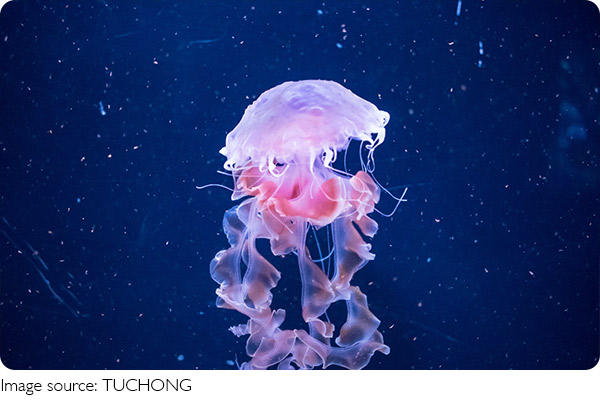Jellyfish Stings First Aid

Hey Lykkers! A fun day at the beach can quickly take a turn if you encounter a jellyfish. These seemingly harmless creatures can deliver a painful sting that can cause anything from mild irritation to severe allergic reactions.
Don’t panic! Knowing how to administer proper first aid can make all the difference. Here’s what you need to know to handle a jellyfish sting like a pro!
Step 1: Get Out of the Water Immediately
If you’ve been stung by a jellyfish, the first thing you should do is exit the water calmly. Moving quickly may spread the venom or attract more jellyfish. Once you’re on the shore, avoid rubbing or touching the affected area with your hands.
Step 2: Remove Tentacles Carefully
Jellyfish tentacles can remain attached to your skin and continue to release venom even after the initial sting. To remove them safely:
Use Tweezers or a Credit Card: Use tweezers, the edge of a credit card, or a similar object to gently scrape off any visible tentacles. Avoid using your bare hands to prevent further stings.
Do Not Rub the Area: Rubbing the sting can cause more venom to be released, increasing pain and irritation.
Step 3: Rinse with Vinegar
Vinegar is the magic potion for neutralizing jellyfish venom!
Why Vinegar? Vinegar (acetic acid) can deactivate the stingers of certain types of jellyfish, like box jellyfish, preventing them from releasing more venom.
How to Apply: Gently pour vinegar over the affected area for about 30 seconds. If vinegar is unavailable, use seawater instead. Do not use fresh water, as it can trigger the release of more venom.

Step 4: Soak or Apply Heat
After neutralizing the stingers, focus on alleviating the pain.
Hot Water Immersion: Soak the affected area in hot water (not scalding) for 20-45 minutes. The heat helps reduce pain and inactivate toxins. Make sure the water is comfortable and not too hot.
Use Heat Packs: If hot water isn't available, a heat pack or warm cloth can also help relieve pain.
Step 5: Take Pain Relief
Pain relief is crucial to managing discomfort from jellyfish stings.
Over-the-Counter Medications: Take pain relievers like ibuprofen or acetaminophen to help reduce pain and inflammation. Follow the recommended dosage on the package or as directed by a healthcare professional.
Step 6: Monitor for Allergic Reactions
It’s essential to keep an eye out for signs of a severe allergic reaction, as jellyfish stings can sometimes cause anaphylaxis.
Symptoms to Watch: Difficulty breathing, chest pain, swelling of the face or throat, dizziness, or severe itching are signs of a possible allergic reaction. Seek emergency medical help immediately if any of these symptoms occur.
The first aid for jellyfish stings
Video By CPR Kids TV
Step 7: Apply Topical Creams
After initial treatment, you might need to soothe the skin.
Hydrocortisone Cream: Apply a mild hydrocortisone cream or calamine lotion to reduce itching and redness.
Antihistamines: Oral antihistamines like diphenhydramine can help manage itching and minor allergic reactions.
What NOT to Do: Common Mistakes to Avoid
Avoid these mistakes to ensure proper first aid:
1. Do Not Use Fresh Water: Freshwater can cause stingers to release more venom, increasing pain.
2. Avoid Urine: Contrary to popular myth, urine is not an effective treatment and can worsen the sting.
3. Don’t Apply Pressure Bandages: Applying pressure can spread venom further into the body, increasing symptoms.
When to Seek Medical Attention
Knowing when to seek professional help is crucial.
Severe Reactions: If the sting covers a large area or if the person stung experiences trouble breathing, chest pain, or any signs of anaphylaxis, seek emergency medical attention immediately.
Persistent Symptoms: If pain persists for more than a few hours or if there are signs of infection (such as increased redness, swelling, or pus), consult a healthcare professional.
Prevention: How to Avoid Jellyfish Stings
An ounce of prevention is worth a pound of cure!
Wear Protective Clothing: If you’re swimming in areas known for jellyfish, consider wearing a wetsuit or rash guard.
Avoid Jellyfish Areas: Stay out of the water during jellyfish season or when warnings are posted.
Look Out for Jellyfish: Always keep an eye out for jellyfish in the water and on the beach.
Jellyfish stings can be painful, but with the right knowledge and quick action, you can effectively treat a sting and minimize discomfort. Remember these steps next time you head to the beach, and enjoy a safe, sting-free day in the sun!

 · Animal Team
· Animal Team